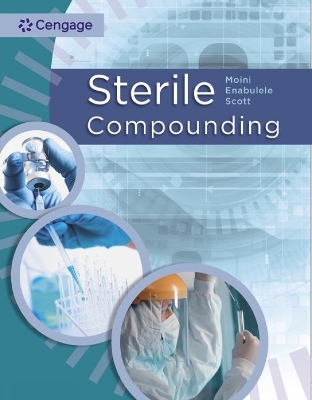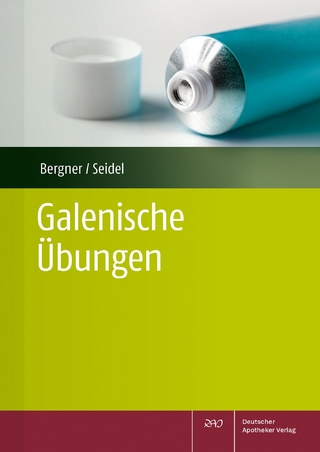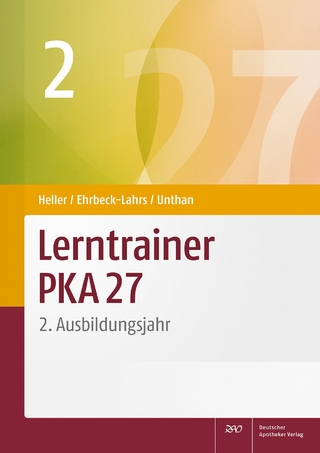
Sterile Compounding
Delmar Cengage Learning (Verlag)
978-0-357-76604-0 (ISBN)
- Lieferbar (Termin unbekannt)
- Versandkostenfrei innerhalb Deutschlands
- Auch auf Rechnung
- Verfügbarkeit in der Filiale vor Ort prüfen
- Artikel merken
Dr. Enabulele is currently practicing as a clinical pharmacist with Children’s Hospital Colorado. Her focus is in clinical research as a part of the Investigational Drug Services team where she is involved with drug therapies for diseases in children, including rare diseases. She obtained her PharmD from the University of Benin, Nigeria, after which she proceeded to receive graduate training in Business Administration (MBA) and Pharmaceutical Sciences (MS) at Georgia Southern University, Statesboro, GA. Her career spans over 8 years’ experience in retail and hospital pharmacy settings, with a significant proportion being in sterile compounding. Dr. Enabulele is an active member of American Society of Health-System Pharmacists (ASHP) and through her pharmacy practice, continues to contribute to the development of standards and procedures that guide pharmacy operations in different settings. Anthony Scott, Pharm.D., MBA, obtained his PharmD from The University of Georgia and his MBA in Healthcare Management from New England College. He completed a PGY-1 Pharmacy Practice Residency at Piedmont Hospital in Atlanta, GA and then completed his PGY-2 Health-System Pharmacy Administration Residency at the North Florida - South Georgia VA Medical Center in Gainesville, FL. He is also a diplomat of the ASHP Foundation Pharmacy Leadership Academy. He is currently serving as the Director of Pharmacy at Emory University Hospital, a role in which he oversees all acute care services for the inpatient department. Prior to Emory, he served as the Assistant Director of Pharmacy Operations at The University of Chicago Medicine (UCM) and was also the PGY1/2 Health-System Pharmacy Administrative Residency program director at UCM. Anthony has been an active member of the American Society of Health-System Pharmacists (ASHP) and the Georgia Society of Health-System Pharmacists (GSHP) since returning to the state of Georgia, currently serving on the Professional Affairs and Communications committees. He previously served on several committees and workgroups with the Illinois Council of Health System Pharmacists (ICHP) as well. Jahangir Moini, M.D., M.P.H., C.Ph.T., is a retired professor of health and science who taught at Eastern Florida State College. Dr. Moini previously served as director of the allied health programs at Everest University, where he initially established the pharmacy technician program while serving as program director. Prior to coming to the United States he served as assistant professor at Tehran University, Medical School. An internationally published author of 53 allied health textbooks, Dr. Moini devotes himself to helping students successfully prepare for a variety of health-related careers.
1. INTRODUCTION.
Overview. History of Sterile Compounding. Requirements for Sterile Compounding. Types of Sterile Compounding. Hospital Pharmacy Compounding. Ambulatory Care Compounding. Nuclear Pharmacy Compounding. Factors Affecting Sterile Compounding. Stability. Temperature. Pressure and Humidity. Growth Media. Key Terms. References.
2. SAFETY IN THE WORKPLACE .
Overview. Occupational Safety and Health Administration (OSHA). OSHA Standards. The Hazard Communication Standard. The Bloodborne Pathogen Standard. Fire Safety and Emergency Plan. Environmental Pollution. Latex Allergy. Work-Related Musculoskeletal Disorders. Exposure Reduction to Chemotherapeutic Agents. Safe Handling of Cytotoxic and Hazardous Medications. Cleaning Up a Spill. Hazardous Waste Management. Defining Hazardous Waste. Disposal of Hazardous Wastes. Key Terms. References.
3. EQUIPMENT, GARMENTS, AND GOWNING.
Overview. Equipment. Syringes. Needles. Ampules. Vials. Filters. Intravenous Tubing. Vented Tubing. Intravenous Bags. Dispensing Pins. Port Adapters. Vented Spike Adapters. Auxiliary Labels. Sharps Containers. Refrigerators. Freezers. Computer Terminals and Software. Carts. Locker Facilities. Miscellaneous Equipment. Balances. Warming Cabinets. Garments. Gowns. Gloves. Face Masks. Shoe Covers. Gowning. Gowning Techniques. Key Terms. References.
4. ASEPTIC TECHNIQUE AND CLEAN ROOMS.
Overview. Microorganisms. Bacteria. Viruses. Types of Infections. Methods of Transmission. Personnel. Environment. Instruments. Principles of Asepsis. Medical Asepsis. Hand Hygiene. Cleaning and Disinfection. Aseptic Technique. Key Terms. References.
5. LAMINAR AIRFLOW WORKBENCHES.
Overview. Clean Rooms. Ante Area. Buffer Area. Containment Segregated Compounding Area. Segregated Compounding Area. Clean Air Environments. Laminar-Airflow Hoods. Types of Laminar Airflow Systems. Cleaning of Hoods and Clean Rooms. Key Terms. References.
6. PHARMACY CALCULATIONS.
Overview. Dosage. Powder Volume. Flow Rates. Key Terms. References.
7. STERILE COMPOUNDING AND PREPARATIONS.
Overview. Personal Training. Parenteral Preparations. Non-injectable Products. Dialysis Solutions. Irrigations. Ophthalmics. Intravenous Products. Small-Volume Parenteral. Large-Volume Parenteral. Total Parenteral Nutrition. Factors Affecting Parenteral Products. Administration Techniques. Intermittent Infusion. Continuous Infusion. Rapid Direct Injection. Intravenous Therapy Equipment. Preparation of Parenteral Products. Laminar-Airflow Hoods. Role of the Technician. U.S. Pharmacopeia (USP) Chapter <797>. Compounding Records. Policies and Procedures for Sterile Product Preparation. Procedures for Handling and Preparing Parenteral Products. Visual Inspection of the Parenteral Product. Preparation of IV Admixtures. Compounding a TPN Product. Preparing an IV Piggyback. Key Terms. References.
8. UNITED STATES PHARMACOPEIA (USP).
Overview. USP <797> Pharmaceutical Compounding – Sterile Preparations. USP <800> Hazardous Drugs. USP <825> Radiopharmaceuticals. Key Terms. References.
9. REPACKAGING, LABELING, STORAGE, DISPOSAL.
Overview. Repackaging of Drugs. Special Packaging Requirements. Unit-Dose System. Single-Unit Packaging. Single-Dose Packaging.
Repackaging Equipment. Packaging of Oral Solid Systems. Packaging of Oral Liquid Systems. Commonly Repackaged Drugs. Oral Liquids.
Topical Drugs. Labeling. Record Keeping. Storage. Disposal. Key Terms. References.
10. RECORD-KEEPING REQUIREMENTS.
Overview. Training and Competency Evaluations. Results of Hand Hygiene and Garbing. Aseptic Technique. Results of Viable Air and Surface Sampling. Biannual Clean Room Airflow Tests. Room Temperature Documentation.
Refrigerator Temperature Documentation. Freezer Temperature Documentation. Sterile Compounding Area Documentation. Daily Air Pressure and Velocity Documentation. Facility and Equipment Cleaning Logs. Documentation of Expired or Recalled Substances. Master Formula Document. Preparation Compounding Log. End-Product Evaluation Testing. Key Terms. References.
11. QUALITY CONTROL AND ASSURANCE.
Overview. Policies and Procedures. Influencing Factors. Medication Errors. Quality Improvement. Agency Guidelines. Food and Drug Administration. American Society of Health System Pharmacists. The Joint Commission on Accreditation of Healthcare Organizations. Center for Drug Evaluation and Research. American Medical Association. Centers for Disease Control and Prevention. Role of the Pharmacy Technician. Key Terms. References.
Appendix A: Examples of Compounding Formulas.
Appendix B: Sample Practitioners for Sterile Compounding.
Answer Keys.
Glossary.
Index.
| Erscheinungsdatum | 12.04.2023 |
|---|---|
| Verlagsort | Clifton Park |
| Sprache | englisch |
| Maße | 220 x 279 mm |
| Gewicht | 499 g |
| Themenwelt | Medizin / Pharmazie ► Pflege |
| Medizin / Pharmazie ► Pharmazie ► PTA / PKA | |
| ISBN-10 | 0-357-76604-0 / 0357766040 |
| ISBN-13 | 978-0-357-76604-0 / 9780357766040 |
| Zustand | Neuware |
| Haben Sie eine Frage zum Produkt? |
aus dem Bereich


